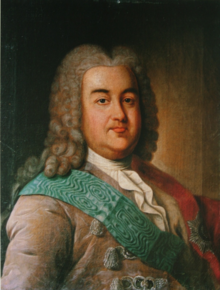You can help expand this article with text translated from the corresponding article in Russian. (February 2023) Click [show] for important translation instructions.
|
Alexey Mikhailovich Cherkassky | |
|---|---|
 Alexey Cherkassky | |
| Born | 1680 |
| Died | 1742 Moscow, Russian Empire |
| Nationality | Russian |
| Other names | Aleksey Mikhailovich Tcherkassky |
| Occupation | Russian Chancellor |
Prince Alexey Mikhailovich Cherkassky or Tcherkassky (Russian: Алексей Михайлович Черкасский, 1680–1742) was the Chancellor of the Russian Empire in the beginning of Empress Elizabeth's reign.[1][2]
Life
[edit]Prince Cherkassky stemmed from one of Russia's richest families which descended from the sovereign rulers of Circassia, a relation to Prince Alexander Bekovich-Cherkassky. His surname translates as "Circassian".
In 1702, Prince Cherkassky held a post of senior stolnik (tsar's personal assistant) and was soon assigned to assist his father, Prince Mikhail Yakovlevich Cherkassky, who had been a voivod in Tobolsk at that time. Tcherkassky served under his father for 10 years and in 1714 was summoned to Saint Petersburg. There, he was appointed member of the Urban Construction Commission.
In 1719, Peter the Great sent Aleksey to Siberia as governor. In 1726, he became a senator. During the election of Anna Ivanovna for the Russian throne in 1730, Cherkassky, the richest man in Russia in terms of the amount of serfs he owned at that time, was in charge of the gentry party, which had been in opposition to the verkhovniki (members of the Supreme Privy Council).
For his services to the Crown he was appointed one of the three cabinet ministers and was promoted to the rank of grand chancellor in 1740. As a cabinet minister, Tcherkassky signed a trade agreement with Great Britain in 1734. In his post as chancellor, he signed a treaty with Prussia in 1740 and Great Britain in 1741.
A Baroque palace built for Prince Cherkassky on Palace Quay to Yeropkin's designs has been rebuilt into the Novo-Mikhailovsky Palace.
References
[edit]- ^ Sartori, Paolo (December 2020). "A Sound of Silence in the Archives: On Eighteenth-Century Russian Diplomacy and the Historical Episteme of Central Asian Hostility". Itinerario. 44 (3): 552–571. doi:10.1017/S0165115320000340. ISSN 0165-1153.
- ^ "ЭСБЕ/Черкасский, Алексей Михайлович — Викитека". ru.wikisource.org (in Russian). Retrieved 2023-02-16.
External links
[edit] Media related to Aleksey Cherkassky at Wikimedia Commons
Media related to Aleksey Cherkassky at Wikimedia Commons